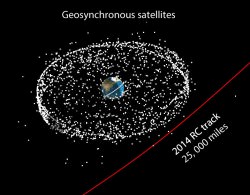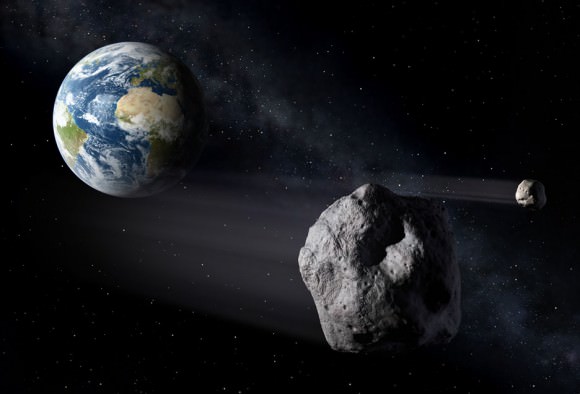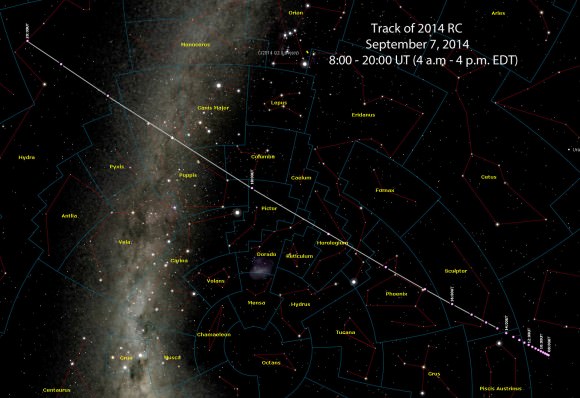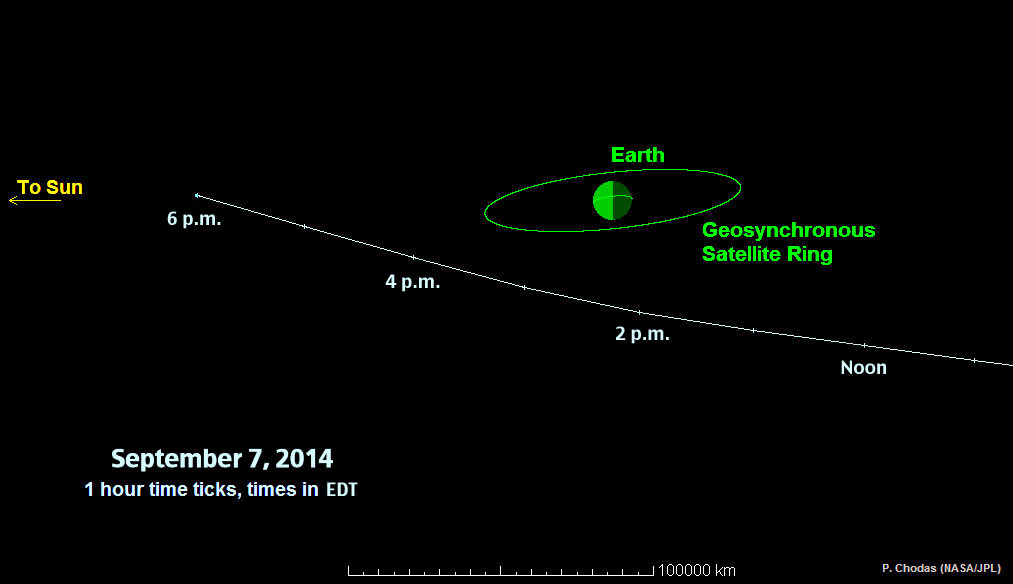Guess who’s dropping by for a quick visit this weekend? On Sunday, a 60-foot-wide (20-meters) asteroid named 2014 RC will skim just 25,000 miles (40,000 km) from Earth. That’s within spitting distance of all those geosynchronous communication and weather satellites orbiting at 22,300 miles.
Size-wise, this one’s similar to the Chelyabinsk meteorite that exploded over Russia’s Ural Mountains region in February 2013. But it’s a lot less scary. 2014 RC will cleanly miss Earth this time around, and although it’s expected back in the future, no threatening passes have been identified. Whew!

NEOs or Near Earth Asteroids are defined as space rocks that come within about 28 million miles of Earth’s orbit. Nearly once a month astronomers discover an Earth-crossing asteroid that passes within the moon’s orbit. In spite of hype and hoopla, none has threatened the planet. As of February 2014, we know of 10,619 near-Earth asteroids. It’s estimated that 93% of all NEOs larger than 1 km have been discovered but 99% of the estimated 1 million NEOs 100 feet (30-meters) still remain at large.
No surprise then that new ones pop up routinely in sky surveys. Take this past Sunday night for example, when the Catalina Sky Survey nabbed 2014 RA, a 20-foot (6-meter) space rock that whistled past Earth that evening at 33,500 miles (54,000 km). It’s now long gone.

2014 RC was picked up on or about September 1-2 by both the Catalina Sky Survey and Pan-STARRS 1 survey telescope atop Mt. Haleakala in Maui. The details are still being worked out as to which group will take final discovery credit. Based on current calculations, 2014 RC will pass closest to Earth around 2:15 p.m. EDT (18:15 UT) on Sunday, September 7th. When nearest, the asteroid is expected to brighten to magnitude +11.5 – too dim for naked eye observing but visible with a good map in 6-inch and larger telescopes.
Seeing it will take careful planning. Unlike a star or planet, this space rock will be faint and barreling across the sky at a high rate of speed. Discovered at magnitude +19, 2014 RC will brighten to magnitude +14 during the early morning hours of September 7th. Even experienced amateurs with beefy telescopes will find it a challenging object in southern Aquarius both because of low altitude and the unwelcome presence of a nearly full moon.
64-frame movie showing Toutatis tumbling through space only 4.3 million miles from Earth on Dec. 12-13. Credit: NASA/Goldstone radar
Closest approach happens in daylight for North and South America , but southern hemisphere observers might spot it with a 6-inch scope as a magnitude +11.5 “star” zipping across the constellations Pictor and Puppis. 2014 RC fades rapidly after its swing by Earth and will quickly become impossible to see in all amateur telescopes, though time exposure photography will keep the interloper in view for a few additional hours.

Most of us won’t have the opportunity to run outside and see the asteroid, but Gianluca Masi and his Virtual Telescope Project site will cover it live starting at 6 p.m. EDT (22:00 UT). Lance Benner, who researches radar imaging of near-Earth and main-belt asteroids, hopes to image 2014 RC with 230-foot (70-m) radar dish at the Goldstone complex on September 5-7 and possibly the big 1,000-foot (305-m) radar dish at Arecibo. Both provide images based on radar echoes that show asteroids up close with shapes, craters, ridges and all.


While at NASA Ames, I learned quite a bit about meteorites and asteroids from affiliations with NASA & SETI experts. While we are discovering a new Near-Earth Asteroid (NEA) in the 10 meter size range about once a month, the coverage of the sky remains pretty slight and slim (pun intended). Catalina was working in conjunction with Siding Spring Observatory (Southern Hemisphere) but funding was cut to Siding last year and I do not think it has returned. Nightly coverage of the southern sky in search of NEAs is very poor.
For every NEA found, as you mentioned, about 1 new one per month (previously discovered NEAs also pass by Earth so there are several in a months time), there are 3 or 4 or more that are missed; one notable example, Chelyabinsk.
Some of the NEAs approach Earth during daylight hours, in the glare of the Sun. Half the asteroids approach us from outside our orbit and half from inside our orbit. A percentage of the latter are the ones hidden in daylight. This was the case of 2014RA last Sunday. When they pass us, their position in the sky switches from the Sun direction to opposing it. They become well lighted and reside in night sky and some are discovered. Altogether, this is a big reason why a specialized space telescope (B612, Sentinel) is needed.
Thanks for reporting on this close call.